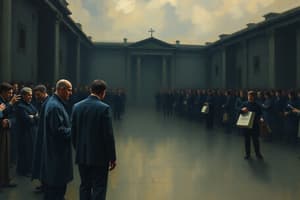Podcast
Questions and Answers
What does the phenomenon of 'Incarceration Nation' describe?
What does the phenomenon of 'Incarceration Nation' describe?
- People are permanently imprisoned
- People cycle in and out of prison and are trapped by their second-class status (correct)
- Prisoners are treated equally in society
- Prison systems are always effective
What is the difference between implicit and explicit bias in law enforcement?
What is the difference between implicit and explicit bias in law enforcement?
Implicit bias refers to unconscious beliefs while explicit bias involves overt discrimination based on race.
The Supreme Court ruled in Whren v. U.S. that police officers are not entitled to use pretext stops.
The Supreme Court ruled in Whren v. U.S. that police officers are not entitled to use pretext stops.
False (B)
What was the main argument in McClesky v. Kemp?
What was the main argument in McClesky v. Kemp?
What does the 14th Amendment's Equal Protection Clause ensure?
What does the 14th Amendment's Equal Protection Clause ensure?
What is meant by prosecutorial discretion?
What is meant by prosecutorial discretion?
What did the Baldus Study find regarding murder cases in Georgia?
What did the Baldus Study find regarding murder cases in Georgia?
The 8th Amendment allows for cruel and unusual punishment.
The 8th Amendment allows for cruel and unusual punishment.
What is the federal penalty ratio for crack vs. powder cocaine offenses?
What is the federal penalty ratio for crack vs. powder cocaine offenses?
What did the Supreme Court recognize in Yick Wo v. Hopkins?
What did the Supreme Court recognize in Yick Wo v. Hopkins?
What is a catch-22 in relation to Armstrong v. U.S.?
What is a catch-22 in relation to Armstrong v. U.S.?
What is the issue highlighted in Batson v. Kentucky regarding juries?
What is the issue highlighted in Batson v. Kentucky regarding juries?
What does the court ruling in Purkett v. Elm permit?
What does the court ruling in Purkett v. Elm permit?
What are peremptory strikes in jury selection?
What are peremptory strikes in jury selection?
How do police exercise discretion in racial profiling?
How do police exercise discretion in racial profiling?
What is the definition of 'stop and frisk'?
What is the definition of 'stop and frisk'?
What conclusion does the NJ Attorney General Racial Profiling Study draw about racial profiling?
What conclusion does the NJ Attorney General Racial Profiling Study draw about racial profiling?
What does Title VI of the Civil Rights Act of 1964 prohibit?
What does Title VI of the Civil Rights Act of 1964 prohibit?
What did Alexander v. Sandoval determine?
What did Alexander v. Sandoval determine?
Flashcards are hidden until you start studying
Study Notes
Incarceration Nation
- Individuals experience a cycle of imprisonment leading to a perpetual second-class status.
- This phenomenon creates a "closed circuit of perpetual marginality," where released individuals struggle to reintegrate into mainstream society.
Colorblind Society vs. Bias in Law Enforcement
- A colorblind society implies no racial biases and equal treatment for all.
- Implicit bias refers to unconscious beliefs about racial neutrality; explicit bias is overt discrimination.
- Despite the ideal of colorblindness in law enforcement, biases persist.
Whren v. US
- The Supreme Court upheld police authority to make pretext stops, ruling it does not violate the Fourth Amendment.
- Concerns were raised regarding targeting African Americans, but the Court allowed challenges under the equal protection clause.
McClesky v. Kemp
- Warren McClesky, a Black man, argued against Georgia's racially biased death penalty scheme after being convicted for killing a white officer, highlighting systemic issues in criminal justice.
14th Amendment - Equal Protection Clause
- Guarantees equal treatment under the law for all individuals, regardless of race or gender.
Prosecutorial Discretion
- Prosecutors possess the power to dismiss cases, file additional charges, offer plea deals, and transfer cases to federal court, affecting case outcomes.
Baldus Study
- Analyzed over 2,000 murder cases in Georgia, demonstrating that those charged with killing white victims faced the death penalty 11 times more frequently than those charged with killing Black victims.
8th Amendment
- Prohibits cruel and unusual punishment, ensuring humane treatment for all defendants.
100:1 Ratio (Crack vs. Powder Cocaine)
- Federal laws impose 100 times harsher penalties for crack cocaine offenses compared to powder cocaine, reflecting racial disparities in drug enforcement.
Yick Wo v. Hopkins
- Addressed the issue of racially selective enforcement when San Francisco denied Chinese businesses laundry licenses; the Supreme Court ruled this violated equal protection.
Armstrong v. US - Catch-22 Decision
- Required evidence for selective prosecution claims must typically be acquired from the prosecutor's files, complicating the process for defendants.
Batson v. Kentucky - All-White Juries
- Emphasized the risk of all-white juries due to limited minority representation in jury pools, which can lead to racial bias in verdicts.
Purkett v. Elm
- The Supreme Court ruled that any race-neutral reason provided by prosecutors for jury strikes satisfies legal requirements, regardless of the reasonableness of that justification.
Peremptory Strikes (Juries)
- Allows attorneys to reject jurors without cause, intending to improve fairness but leading to discriminatory practices in jury selection.
Racial Profiling
- Encompasses police practices that target individuals and communities based on race, undermining impartiality in law enforcement.
"Stop and Frisk"
- A legal practice permitting brief stops of suspects based on reasonable suspicion, often criticized for its discriminatory application.
NJ Attorney General Racial Profiling Study
- Highlighted the flawed logic behind racial profiling, where law enforcement cites incarceration rates of minorities as justification rather than recognizing profiling as the root cause.
Title VI of the Civil Rights Act of 1964
- Prohibits discrimination in federally funded programs based on race, employing a "disparate impact test" to assess discrimination claims.
Alexander v. Sandoval
- The Supreme Court's ruling effectively eliminated remaining opportunities to contest racial bias in the criminal justice system.
Studying That Suits You
Use AI to generate personalized quizzes and flashcards to suit your learning preferences.




